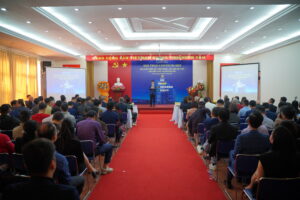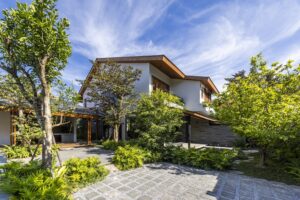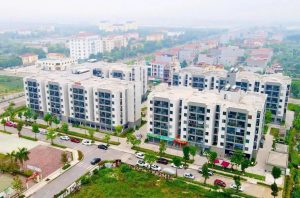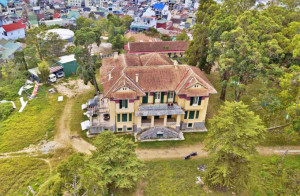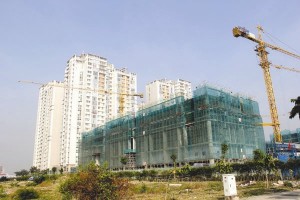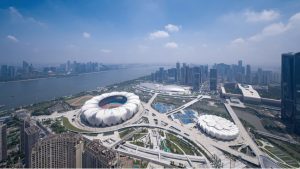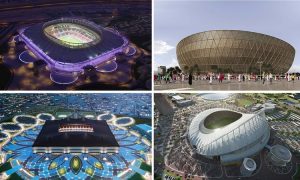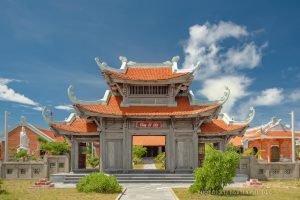Công bố quốc tế trong lĩnh vực kiến trúc, xây dựng (Tuần 2 tháng 11-2021)
Trong số này chúng tôi xin giới thiệu tới quý độc giả những nội dung chính của các công bố quốc tế đăng tải trên ScienceDirect và Springer Nature do Cục Thông tin khoa học và công nghệ quốc gia (NASATI) mua quyền truy cập như sau:
Quy hoạch đô thị:
– Phân tích tác động của cấu trúc đô thị 2D và 3D đối với những thay đổi của LST sử dụng dữ liệu cảm biến từ xa
– Khung phân loại đa chiều các thành phố liên quan đến khái niệm thành phố bền vững và thông minh ứng dụng cho các thủ đô của Brazil
– Mô hình tiêu thụ năng lượng cho kho tòa nhà dân cư Algeria, dựa trên cách tiếp cận tam giác: Hệ thống thông tin địa lý (GIS), phân tích hồi quy và phân tích cụm phân cấp
– Khả năng tương thích của các giao thức thu thập dữ liệu định lượng và định tính để đánh giá cảnh quan đô thị
– Phân loại dựa trên xác suất để mô tả môi trường được xây dựng xung quanh các ga đường sắt đô thị
– Một phương pháp thiết kế kiến trúc và đô thị chung thông qua mạng nơ ron nhân tạo
– Thiết kế lại hệ thống quản lý bền vững hương vị sinh học đô thị dựa trên khái niệm sinh thái công nghiệp: Một nghiên cứu điển hình ở Trung Quốc
– Ảnh hưởng của thiết kế thích ứng với khí hậu đối với hiệu suất nhiệt và năng lượng: Một nghiên cứu dựa trên mô phỏng ở vùng Nam Algeria khô nóng
– Các giải pháp tối ưu để thiết kế vị trí tiếp cận thẳng đứng trong các tòa nhà cao tầng dân cư dựa trên hành vi của con người
Khoa học và công nghệ trong lĩnh vực kiến trúc, xây dựng:
– Phân tích hình thái và khoáng vật học của sợi Diss đã qua xử lý và ảnh hưởng của chúng đến các đặc tính cơ lý của bê tông Diss dựa trên chất kết dính thay thế
– Đặc trưng hóa các hành vi nứt do mỏi của mặt đường OGFC bằng cách sử dụng máy kiểm tra lớp phủ
– Nghiên cứu thực nghiệm về ứng xử ngoài mặt phẳng của tường xây bằng gạch có mối nối lớp giảm chấn
– Phát hiện các vị trí nguồn trong cột RC bằng cách sử dụng máy học với dữ liệu phát xạ âm thanh
– Tối ưu hóa thiết kế dựa trên độ tin cậy của cầu xem xét sự tương tác giữa cầu-xe bằng mô hình đại diện Kriging
– Nghiên cứu cơ chế liên kết neo đúc nóng của cáp thép bọc Galfan
– Giảm thiểu năng lượng hiện có của hệ thống sàn bê tông cốt thép ở các nước đang phát triển thông qua tối ưu hóa hình dạng
– Ứng dụng của giằng chống vênh trong thiết kế chịu động đất của các tòa nhà
– Đánh giá các cấu trúc bị ảnh hưởng bởi phản ứng Alkali-Silica (ASR) bằng mô hình đồng nhất của bê tông cốt thép
Vật liệu xây dựng:
– Tính chất cơ học của vật liệu composite cốt sợi hoạt tính kiềm có độ dẻo cao với các độ tuổi đóng rắn khác nhau
– Tính chất liên kết giữa vữa xi măng magiê-photphat-xi măng biến tính bằng thủy tinh nano-Al2O3-nước và sợi thép
– Thiết kế tối ưu vật liệu vữa geopolymer cho mặt đường bán dẻo dựa trên phương pháp luận bề mặt đáp ứng
– Độ bền của vật liệu vữa gốc xi măng vi sinh hiệu quả mới trong môi trường ăn mòn
– Đặc điểm và tính chất của bọt geopolymer gốc tro bay loại C: Ảnh hưởng của hàm lượng chất tạo bọt, cốt liệu và chất hoạt động bề mặt
– Cặn đá phiến dầu nung làm vật liệu kết dính bổ sung cho xi măng poóc lăng thông thường
– Độ bền của bê tông bột phản ứng chứa phụ gia khoáng trong môi trường xói mòn do nước biển
– Khảo sát biến dạng mở rộng tự do của bê tông trong quá trình gia nhiệt
– Mô phỏng số hóa cơ chế điện hóa ăn mòn cốt thép trong bê tông trong điều kiện khí hậu tự nhiên với nhiệt độ và độ ẩm thay đổi theo thời gian
– Khảo sát thực nghiệm dầm gỗ ghép thanh, mối ghép vành khăn.
Xin trân trọng giới thiệu!
QUY HOẠCH ĐÔ THỊ
1.Analyzing the effects of 2D and 3D urban structures on LST changes using remotely sensed data
Sustainable Cities and Society, Volume 74, November 2021, 103216
Abstract
2D and 3D urban structures play an important role in characterizing Land Surface Temperature (LST). The effects of 2D urban structures on changes of LST have been studied in many studies, but less attention has been paid to the effects of 3D urban structures. Therefore, in this study, we aimed at employing LiDAR point clouds and a Landsat-8 image to investigate the effects of 2D and 3D structures on LST changes in Tartu, Estonia. To this end, LST retrieval and extraction of 2D structures were carried out using a Landsat-8 image. A 3D land cover of the study area was generated through employing random forest (RF) classifier on a joint set of features extracted from LiDAR point clouds and an orthophoto image, as a basis to identify 3D structures. The results of this study indicate a high overall accuracy (97.33%) of RF in land cover classification. Among the 2D structures, Normalized Difference Built-up Index (NDBI) had a higher correlation than Fractional Vegetation Cover (FVC) with LST. The results also indicate the significant role of height in impervious surfaces and vegetation in increasing and decreasing LST. Finally, the results showed that the hot spots emerged in areas where the mean height of impervious surfaces was higher, while the cold spots were linked to areas of higher mean vegetation heights.
2.Influencing factors and their influencing mechanisms on urban resilience in China
Sustainable Cities and Society, Volume 74, November 2021, 103210
Abstract
With an increase in disturbance in cities, improving urban resilience has become a global consensus in order to achieve sustainable urban development. As the largest developing country in the world, China must improve its urban resilience to withstand various threats during its rapid development. Therefore, it is critical to identify key influencing factors and their influencing mechanisms on urban resilience in China. To achieve this objective, this study identified 12 key influencing factors through literature review and Delphi method under a 4R (i.e., robustness, rapidity, redundancy, and resourcefulness) framework, and used the DEMATEL and ISM methods to investigate their influencing mechanisms. The results indicate that: 1) Policy system is the most important cause factor and resource allocation is the most important effect factor; 2) Factors of resourcefulness are fundamental factors influencing urban resilience. Factors of robustness and rapidity are direct factors influencing urban resilience; 3) There are five influencing paths of influencing factors among the 4R dimensions. Resourcefulness could directly influence robustness, redundancy and rapidity. Redundancy could directly influence robustness and rapidity. In the end, three implications are proposed, including improving the policy system, strengthening the assessment of urban resilience, and integrating resilience concept into the urban system.
3.Multidimensional sorting framework of cities regarding the concept of sustainable and smart cities with an application to Brazilian capitals
Sustainable Cities and Society, Volume 74, November 2021, 103193
Abstract
The concept of a smart and sustainable city refers to a city that uses information and communication technologies (ICTs) and other means to improve the quality of life and urban services in order to meet the current and future needs. The main objective of this research is to propose a multidimensional assessment of cities from the aspects of a smart and sustainable city, through a sorting multicriteria analysis. Therefore, the model developed by the European Telecommunications Standards Institute (ETSI) was adapted and the FITradeoff method was used because it requires only partial information. The applicability of the proposal was illustrated by an application to Brazilian capitals. The results show that there is weakness on the part of the Brazilian capitals in relation to their access to and development of technology, innovation, local attractiveness and economic issues. Moreover, the capitals of the Northeast region of Brazil have lower performance compared to the cities of the South, Southeast and Midwest regions. Finally, this study can serve as a support tool in the decision process for managers, city planners and private sector entities seeking development strategies in relation to the theme, as well as helping to mitigate the gap found in the literature.
4.An energy consumption model for the Algerian residential building’s stock, based on a triangular approach: Geographic Information System (GIS), regression analysis and hierarchical cluster analysis
Sustainable Cities and Society, Volume 74, November 2021, 103191
Abstract
Modelling residential energy consumption (REC) represents a key step towards the implementation of energy transition policies for more sustainable cities. Developing such policies requires considering the characteristics of the residential building stock (RBS). In the literature, REC modelling is generally applied on a single or set of cities-provinces, through limited approaches, using data from one typical year. In this paper, an energy consumption model for the entire Algerian RBS is developed through a triangular approach combining Geographic Information System, regression analysis and hierarchical clustering, applied to all provinces from 1995 to 2018. This allows mapping the spatial-temporal distribution of REC and RBS, developing a REC model, and dividing all provinces into clusters based on their REC behaviour. Provinces are aggregated into four clusters and four provinces are identified as archetypes. The results highlight that, besides the size of the RBS, REC is highly dependent on the electricity and gas connection rates. However, the influence of GDP and urban density only play a minor role. This can be explained by the evolving demands in thermal comfort associated with access to energy networks. The likely impact of increased gas and electricity connection represents a crucial factor in the design of energy policies.
5.Compatibility of quantitative and qualitative data-collection protocols for urban soundscape evaluation
Sustainable Cities and Society, Volume 74, November 2021, 103259
Abstract
This study investigates the compatibility of soundscape evaluation results based on the data-collection protocols proposed in ISO 12913-2, Method A (questionnaire), Method B (questionnaire and open-answer), and Method C (narrative interview), as well as guidelines for evaluating urban soundscapes. We assessed the soundscapes of 10 multi-functional sites in an urban environment through the responses of 50 participants to questions on sound source identification, perceived affective quality, and overall quality. Using virtual reality technology, we reproduced a laboratory environment similar to the actual assessment sites. The responses to sound source identification were similar for each protocol. Regarding perceived affective quality, the “pleasantness-eventfulness model” derived from Method A was also found in the text-mining results of Methods B and C; additional emotional responses were discovered. Regarding overall quality, the preference for each assessment site was similar for each protocol. Method C revealed the influence of non-acoustic factors on soundscape perception. The quantitative data protocol was appropriate for a large group and for deriving a generalized model, whereas the qualitative data protocol was effective for small groups or an in-depth analysis of certain sites. The findings of this study are useful for assessing urban soundscapes and informing urban planning.
6.Whose park? Crowdsourcing citizen’s urban green space preferences to inform needs-based management decisions
Sustainable Cities and Society, Volume 74, November 2021, 103249
Abstract
Subjective values of urban green spaces are difficult to quantify and thus easily overlooked in planning processes. Accounting for such values is an important challenge in developing sustainable cities. Crowdsourcing methods, such as big data and smart phone applications, have emerged as promising methods to improve insights into subjective perceptions and preferences. However, we know little about how well these relatively new methods actually quantify subjective values. We assessed several of these new methods by comparing observations of use (n = 1009) to three crowdsourcing methods in one large park in Amsterdam, the Netherlands: a dedicated mobile app providing in situ stated preferences (n = 377), passive social media (n = 78) and a municipal reporting app (n = 187). We show that observed use and passive social media only captured user quantity and were not able to identify green space qualities that are important for mental health functions, such as how relaxing or safe a location is. The dedicated mobile app combined with observed use helped to identify priority locations for improvement. Our findings emphasize that if inadequate measures are used in smart city developments, subjective values and specific user groups will continue to be overlooked in planning processes.
7.Probability -based typology for description of built environments around urban rail stations
Building and Environment, Volume 205, November 2021, 108193
Abstract
Urban rail transit has been commonly regarded as an efficient transportation mode for alleviating the negative impacts of rapid urbanization. However, the complex and comprehensive built environment caused by rapid urbanization prevents policymakers and planners from understanding the performance of urban rail transit, particularly around transit stations. Developing station area typologies plays an important role in describing the characteristics of station areas. Numerous studies have developed typologies of station areas over the past decades; however, few have attempted to estimate the distribution of station types per station. To fill this gap, this paper first proposed the importance of a land use type (ILUT) index based on the term frequency-inverse document frequency method. This method avoids mutual concealment among land use types, to extract key built environment features based on built area datasets of the buffer areas of 337 selected urban rail stations in Beijing. Subsequently, the ILUT index was used to estimate the distribution of the station types per station using the latent Dirichlet allocation model. The 12 identified types of urban rail station areas in Beijing demonstrated that land use types consist of station types and presented the distribution of the station types with their probabilities, revealing the current performance of station areas. This paper proposes a description approach that will help policymakers and planners to effectively and efficiently identify and analyze built environment features.
8.A generative architectural and urban design method through artificial neural networks
Building and Environment, Volume 205, November 2021, 108178
Abstract
Machine learning, as a computational tool for finding mappings between the input and output data, has been widely used in engineering fields. Researchers have applied machine learning models to generate 2D drawings with pixels or 3D models with voxels, but the pixelization reduces the precision of the geometries. Therefore, in order to learn and generate 3D geometries as vectorized models with higher precision and faster computation speed, we develop a specific artificial neural network, learning and generating design features for the forms of buildings. A customized data structure with feature parameters is constructed, meeting the requirements of the neural network by rebuilding surfaces with controlling points and appending additional input neurons as quantified vectors to describe the properties of the design. The neural network is first trained with generated design data and then tested by adjusting the feature parameters. The prediction of the generated data shows the basic generative ability of the neural network. Furthermore, trained with design data collected from existing buildings, the neural network learns and infers the geometric design features of architectural design with different feature parameters, providing a data-driven method for designers to generate and analyze architectural forms.
9.Redesign of urban biowaste sustainable management system based on industrial ecology concept: A case study in China
Science of The Total Environment, Volume 793, 1 November 2021, 148425
Abstract
Urban biowaste, which refers to the organic fraction of municipal solid waste (MSW), is a predominant type of waste in low- and middle-income countries. Therefore, the sustainable management of urban biowaste is a key problem in solid waste management (SWM). However, treatment technologies usually come with secondary pollution and by-products that need further treatment, which would limit the economic and environmental benefits of the waste management system. The concept of industrial ecology has the potential to be introduced into the waste management field to solve this problem. Based on a practical case study of a city in eastern China, this paper conducted a complete urban biowaste treatment system planning exercise using concepts in industrial ecology. The establishment of the new system has significant economic, environmental and social benefits. The total output value of the project would reach 342 million yuan in 2025, corresponding to 945,000 tons of solid wastes consumed every year, which would significantly reduce the environmental pollution caused by solid waste. More than 700 jobs could also be created. In addition, the establishment of an urban biowaste sustainable management system requires the joint effort of enterprise, government and the public, which in turn requires innovation in business models and management policies. Therefore, a special management committee should be established to promote collaboration among stakeholders, and an online platform that enables end-to-end process supervision covering the entire system, including emergency management mechanisms, needs to be established to ensure the long-term stable operation of various treatment facilities. The results of this paper show that synergies among technologies should be promoted to provide systemic benefit, and that the infrastructure for pollution control should be shared to ensure high utilization.
10.Development and application of practical criteria for the recognition of potential Health Restoration Soundscapes (HeReS) in urban greenspaces
Science of The Total Environment, Volume 793, 1 November 2021, 148541
Abstract
Urban greenspace soundscapes can contribute to the restorative effects that nature provides for the psychological and emotional health of people when certain conditions are met. The main objective of this paper is to propose practical criteria to help planners and managers in the design, development and preservation of urban greenspaces whose soundscapes may contribute to the renewal of health. Systematic literature review informed a conceptual potential Health Restoration Soundscapes (HeReS) model, based on five conditions: (1) Naturalness, (2) Sound Levels, (3) Perceived Sound Sources, (4) Soundscape Assessment, and (5) Sensescape Coherence and proposed Health Restoration Soundscapes Criteria (HeReS-C), for HeReS evaluation in urban green areas. The HeReS-C were applied in 21 sites in Argentina, Sweden, and Chile. General results are provided for all 21 sites, along with three in-depth profiles of HeReS-C applications that provide case studies across a range of resulting HeReS-C scenarios, including sites that meet the HeReS-C criteria, those that do not, and sites that could qualify in the future, if appropriate management measures are taken. HeReS-C showed to be a promising tool for the recognition of potential health-restoring soundscapes in urban greenspaces; informing their design and management to favor the well-being and health of the population.
11.The effect of climate-responsive design on thermal and energy performance: A simulation based study in the hot-dry Algerian South region
Journal of Building Engineering, Volume 43, November 2021, 103023
Abstract
The building sector in Algeria was influenced by French colonisation in terms of typology and materials (in particular, housing sector was the most influenced), but the local traditional architecture is full of forms of harsh climate resistance. The severe hot-dry climate regions are the most affected, due to the high temperature degrees which made the government reducing electricity and gas bills tariff by 65%. The purpose of this paper is to explore the role of passive strategies inspired from traditional architecture in hot-dry climate in affecting the energy demand (cooling and heating loads). A typical case study of El-Miniawy housing in Ouled Djellal with adapted passive strategies is analysed through psychometric chart evaluation, in situ measurement campaign and dynamic simulations (EnergyPlus), to understand its thermal behaviour and energy demand, exploring the impact of seven different scenarios with modified passive strategies and parameters. The results show that the actual design temperatures in the typical hottest days are between 30.1 °C and 35.4 °C, while the external temperature is achieving to 47 °C. Moreover, the building consumes 10.43 kWh/m2 and 19.87 kWh/m2 for cooling and heating demand respectively. It varies according to the different analysed scenarios. This study can be useful for decision makers and architects in Algeria and abroad, towards the climate-responsive design in housing sector.
12.Optimal solutions to vertical access placement design in residential high-rise buildings based on human behavior
Journal of Building Engineering, Volume 43, November 2021, 102856
Abstract
Human behavior at the time of building crisis should be analyzed in order to design buildings with satisfactory performance. In residential high-rise buildings, there are certain complications due to residential conditions. Given the high population density of these buildings, it is important to analyze their vertical access performance for emergency evacuations. This study aims to find the optimal placement and layout of vertical access in residential high-rise buildings. It asks: What is the most optimal solution to vertical access placement design in residential high-rise buildings? To answer this, human behavior simulation models during an emergency evacuation in residential high-rise buildings were first analyzed, and the best model was selected. Based on the human behavior models, the vertical access placement was then optimized to evaluate the optimal structures of four types of 60-story residential buildings designed and compared in SFPE and Steering simulation engines. The scenarios differ in vertical access placement. The simulations are conducted in four parts, which include how people placement on each floor, considering disabled persons along with assisted evacuation, and the fire-involved stories and the blocked stairs. According to the research results, a cost-effective core that solves structural problems and provides vertical access will not necessarily be the right solution to the emergency evacuation of high-rise buildings. Instead, placing vertical access features such as stairs and elevators on two opposite sides of a building plan can reduce the total evacuation time by 20%.
13.Smart performance-based design for building fire safety: Prediction of smoke motion via AI
Journal of Building Engineering, Volume 43, November 2021, 102529
Abstract
The performance-based design (PBD) has been widely adopted for building fire safety over the last three decades, but it requires a laborious and costly process of design and approval. This work presents a smart framework for fire-engineering PBD to predict the smoke motion and the Available Safe Egress Time (ASET) in the atrium by Artificial Intelligence (AI). A CFD database of visibility profile in atrium fires is established, including various fire scenarios, atrium volumes, and ventilation conditions. After the database is trained with the transposed convolutional neural network (TCNN), the AI model can accurately predict the smoke visibility profile and ASET in the atrium fire. Compared to conventional CFD-based PBD by professional fire engineers, AI method provides more consistent and reliable results within a much shorter time. This research verified the feasibility of using AI in fire-engineering PBD, which may reduce the time and cost in creating a fire-safety built environment.
14.Evaluating the heat island effect in a planned residential area using planning indicators
Journal of Building Engineering, Volume 43, November 2021, 102473
Abstract
Through determination of planning indicators (building density, floor area ratio, green coverage ratio, etc.) in urban planning preparation, it can control the intensity of urban development and formation of urban thermal environment after implementation of the planning proposal. Understanding of the relationship between urban planning indicators and thermal environment formation makes it possible to consider the thermal environment in more detail at the planning stage, and optimize the urban planning proposal in mitigation of urban heat island effect (UHI). The primary aim of this study is to propose an analytical method for quantifying UHI in a planned urban area based on planning indicators. This study used an index called heat island potential (HIP) to evaluate UHI in an urban area, and theoretically confirmed that the total daily cumulative HIP for an urban area can be calculated using the daily cumulative HIP for all sub-areas and coverage ratios of land covers (building, pavement, trees, etc.) in the urban area. The sub-areas can be classified to two types: one with buildings, and another without buildings. The daily cumulative HIP for a sub-area with and without buildings can be estimated with regression equations in which planning indicators are variables. This paper presented how to obtain the regression equations for estimating the total daily cumulative HIP in a residential area through a case study in Nanning which is located in the south of China.
15.Mind the gap: A comparison of socio-technical limitations of national house rating systems in the UK and Australia
Journal of Building Engineering, Volume 43, November 2021, 102570
Abstract
This paper reviews the national house rating tools in the UK and Australia, evaluates the energy performance of eight different case study houses, and quantifies the magnitude of the performance gap between as-designed energy performance and as-occupied (actual) energy use. To identify contributing factors to the performance gap, post-occupancy evaluations were conducted, and all case study houses were monitored over two years. It was observed that there are performance gaps in all case study houses, however, the gap can be negative (i.e. more actual energy use than simulated) or positive (i.e. less actual energy use than simulated). Results show that the actual heating loads were less than simulated in 5 of the 8 houses (2 UK and 3 AU), and only 1 house (AU) had an actual cooling load more than simulated. The heating discrepancies ranged from 73% to 180% for the UK houses, and 19%–172% for the AU houses. For the cooling loads, actual energy use in the AU house was up to 4.8 times higher than the simulated.
To understand the underlying causes, several influencing factors (including internal temperature conditions, climate, house form and urban context, construction quality, and processes and assumptions of national house rating tools) were analysed. It was found that a key challenge relates to a limited definition of the energy system (household energy use), focusing on technical issues and largely ignoring or simplifying existing and changing socio-cultural issues. Additionally, the paper argues for the need for extending the system boundary beyond individual buildings to neighbourhood, community and city scales. At both a building scale and community scale, deeper understandings of socio-cultural issues that impact on, and are impacted by, energy metabolism, are required.
KHOA HỌC VÀ CÔNG NGHỆ TRONG LĨNH VỰC KIẾN TRÚC, XÂY DỰNG
1. Morphological and mineralogical analysis of treated Diss fibers and their effect on physico-mechanical characteristics of Diss concrete based on alternative binder
Construction and Building Materials, Volume 307, 8 November 2021, 124936
Abstract
The viability of using vegetable Ampelodesmos Mauritanicus (Diss) fibers to develop lightweight construction material was investigated in this paper. The objective of this work is to assess the physico-mechanical properties of Diss fibers reinforced concrete sample with fibers to binder volume ratio ranged from 0 (control specimen) to 4. In order to mitigate the inhibitory effect exerted by vegetable materials on binder hydration, Diss fibers were treated with hot water, while air lime-based binder has been selected to replace traditionally used cementitious binder. The most important part of this work is focused on the efficiency of using air lime-based binder to develop lightweight construction material containing Diss fibers. Air lime-based binder is the chosen variety of binder due to its abundance and low emissions from its manufacture. The experimental investigation of the chemical compatibility between treated fibers and binder through the hydration-test has shown the effectiveness of boiling water treatment on the modifications of morphological and mineralogical properties to overcome the inhibitory effect exerted when non-treated Diss fibers were used. The hardened specimen properties included dry density, porosity, compressive and flexural strengths, and elastic behavior have been studied. The results have indicated that despite a reduction in compressive strength, the reinforced specimen remains acceptable to be used in lightweight construction applications, as regards its compressive strength-value and lightening level. The flexural strength of reinforced specimen was found to be significantly enhanced. Depending on the amount of Diss fibers used in the mixture, it was found that the optimal addition of Diss fibers is in the range of 3 volumes content. The corresponding flexural strengthening rate has reached a value of 86.5 % higher, due to the several reinforcement mechanisms like the compaction process, Diss fiber bond reinforcement, and also the undisturbed development of hydrate components of air lime-based binder during hardening. Therefore, the addition of Diss fibers generates failure mode change of specimen from the brittle to ductile behavior, which results in improvement of deflection and toughness capacity.
2. Characterizing the fatigue cracking behaviors of OGFC pavements using the overlay tester
Construction and Building Materials, Volume 307, 8 November 2021, 124979
Abstract
The objective of this study was to evaluate the fatigue performance of the composite specimens combined by OGFC and the underlying dense-graded layer (OGFC-AC) by conducting overlay tester (OT) tests. Other two types of specimens, including single layer OGFC13 and single layer AC20, were fabricated to make comparable analysis with OGFC-AC composites. For OGFC-AC specimens, the effects of tack coat application rate and contaminations (soil and oil) were quantificationally explored. Peak tensile stress, cracking rate index (CRI), and dissipated energy were obtained and analyzed. Meanwhile, the damage propagation during the fatigue tests were analyzed using a damage factor. Results indicated that the peak tensile stresses of OGFC-AC composites were somewhere between OGFC13 and AC20. Contaminations would attenuate the peak tensile stress. There existed a power exponential relation between dissipated energy and the load cycle. CRI and damage factor presented the same development law in demonstrating that the fatigue cracking resistance of OGFC13 was superior, followed by AC20, and the performance of OGFC-AC was inferior. The results of CRI and damage factor showed that an optimum tack coat application rate (0.4 kg/m2) existed at which the OGFC-AC composites presented the least cracking potential. The contamination of soil partially increased the cracking resistance, which was probably due to the fact that some sand particles in soil increased the friction and interlock effect between OGFC and the AC layer.
3.Experimental study on out-of-plane behaviour of an infilled masonry wall with damping layer joint
Engineering Structures, Volume 246, 1 November 2021, 112993
Abstract
A damped infilled wall (DIW) is an innovative configuration for improving the in-plane (IP) seismic performance of infilled masonry walls (IMWs) through the introduction of a damping layer joint (DLJ). The out-of-plane (OOP) behaviour of IMWs in an earthquake event plays an important role in their overall seismic performance. This study is aimed at the further investigation of the OOP behaviour and resistance mechanism of a DIW. The OOP behaviour and resistance mechanism of a DIW with a modified-asphalt-waterproof-based (MAW-based) DLJ and mortar-based DLJ are investigated. The results indicate that a DIW with a MAW-based DLJ resists the OOP force mainly via the bending of the masonry unit, while this occurs via the coupled arching action and bending of the masonry unit in the case of a DIW with a mortar-based DLJ. The deformation and damage pattern for the DIW with a MAW-based DLJ and mortar-based DLJ are characterised by the fracture lines of the one-way and two-way slabs, respectively. The OOP capacity of the DIW with a MAW-based DLJ is much lower than that of the DIW with a mortar-based DLJ; however, both of these exhibit ductile behaviour and possess the capacity to resist the maximum earthquake action of the main seismic countries or regions. The DIW is able to remain stable when the OOP displacement at the wall centre reaches 1.2 times the wall thickness.
4.Detection of source locations in RC columns using machine learning with acoustic emission data
Engineering Structures, Volume 246, 1 November 2021, 112992
Abstract
Detecting and monitoring the damage locations of in-service reinforced concrete (RC) structures is difficult as they exhibit more complex geometries and consist of composite materials. In this study, a new method for detecting the source location of acoustic emission (AE) signals in RC structures using machine learning was introduced and tested on an in-service RC column. An impulse response test was conducted using an AE testing system to gather data regarding the source locations. Meanwhile, the source locations on the test column were generated through manual hits. The corresponding AE data were collected using a AE data acquisition system. The significant AE parameters were determined using neighborhood component analysis for feature selection to obtain a dataset for machine learning. Further, a support vector machine classifier was adopted to classify the source locations of the columns for three sensor groups. Furthermore, the source locations were predicted using feedforward backpropagation neural networks. This study validated the detectability of AE signals in RC columns and proposed a novel detection method, which can be employed to perform continuous nondestructive tests on in-service RC columns.
5.Development of a double-stage yielding damper with vertical shear links
Engineering Structures, Volume 246, 1 November 2021, 112959
Abstract
This study proposes a novel hybrid damper called vertical links system with double-stage yielding (VLDY). The VLDY damper consists of two replaceable vertical shear links connected in series, located within a moment-resisting frame (MRF). When the MRF sustains lateral deformation, the minor link yields in shear. The inelastic shear rotation of the minor link increases till the engagement of the lockout mechanism. Thereafter, the inelastic deformation occurs in the major shear link, and the entire system enters the second yielding stage. The minor link can be adjusted to dissipate the input energy in relatively small inter-story drift levels during moderate earthquakes, and the major link maintains the structural integrity under severe earthquake ground motions. A validated nonlinear finite element modeling protocol in ABAQUS/standard was utilized to examine the applicability and cyclic response of the proposed system. The results showed that the VLDY device could provide stable energy dissipation capacity in a wide range of inter-story drift levels ranging from 0.3% to 4%. In addition, the cyclic secant stiffness, energy dissipation capacity, and equivalent viscous damping ratio of the VLDY-equipped frames significantly increased compared with those of the bare frames. Based on the results, a minimum free span-to-depth ratio of 7 has been suggested to ensure the prevention of the steep moment gradient on the story beams.
6.Cyclic behaviour of squat reinforced concrete shear walls strengthened with ultra-high performance fiber reinforced concrete
Engineering Structures, Volume 246, 1 November 2021, 112999
Abstract
Ultra-high performance fiber reinforced concrete (UHPFRC) is now available as an advanced building material for strengthening applications. It is characterized by high strength, ductility, fracture toughness, and good durability. This paper presents an experimental investigation conducted on seismically shear-deficient squat reinforced concrete (RC) shear walls strengthened with casting UHPFRC layers/jacket subjected to lateral quasi-static reversed cyclic loading and a constant axial load. The experiment was conducted on four identical rectangular RC shear walls with a scale of ⅓, an aspect ratio of 1.5 and having low concrete strength. As a reference sample, one of the shear walls was not strengthened with UHPFRC while the other three were strengthened with UHPFRC using different configurations as (i) one layer only on one long side, (ii) two layers on the long sides, (iii) all sides of the wall (jacket). Digital image correlation (DIC) technique was utilized for assessment of the damage mechanism of all specimens. According to the results, the strengthening techniques significantly improved the lateral load strength, ductility, and energy dissipation capacities especially for RC walls strengthened with UHPFRC jacketing. Results indicated the occurrence of debonding failure for the wall strengthened with two UHPFRC layers. The shear and flexural strength capacities of identical wall specimens strengthened with reference concrete were evaluated according to ACI 318 code and their efficiency was compared with test results of UHPFRC strengthened walls. The UHPFRC strengthened techniques increased the lateral load carrying capacities by 70% to 227% of the original wall.
7.A passive stress-strain model for concrete prisms reinforced by a combination of confinement reinforcement
Engineering Structures, Volume 246, 1 November 2021, 112981
Abstract
The strength and ductility of concrete prisms can be significantly enhanced by confinement reinforcement, such as stirrups, wraps, and tubes. Recently, a combination of confinement reinforcement is applied to concrete prisms for their better ductility or a specific use. However, most existing approaches only give the ultimate strength of confined concrete prisms and do not consider the size effect. As a result, these approaches cannot provide structural engineers with a simple tool for the ductility design of concrete prisms with size effect. In this paper, based on the fundamental partial interaction bond-slip and shear-friction mechanisms, a passive stress–strain model of concrete confined by a combination of confinement reinforcement is proposed. The main advantages of the proposed model are that the size effect is considered and it can be applied to concrete members of rectangular or circular cross-section reinforced by novel combinations of confinement reinforcement. After the proposed model is verified with test results of concrete prisms reinforced by FRP wrapping and stirrups/steel tube, it is concluded that this model can be applied in the ductility design of FRP wrapped concrete prisms.
8.Temperature analysis of steel box girder considering actual wind field
Engineering Structures, Volume 246, 1 November 2021, 113020
Abstract
Most existing studies on bridge thermal analysis have ignored the influence of wind on the resultant temperature distribution, in which a constant value of wind speed is applied to all structural surfaces. In fact, the wind blowing across the girder exterior surface significantly affects the heat-transfer convection coefficient and consequently influences the accuracy of the thermal analysis results. For the streamlined steel box girder in particular, the local wind speeds on different surfaces even under the same inflow wind speed could vary significantly, because the steel box girder is composed of multiple surfaces with different azimuth angles. In this paper, a novel thermal analysis methodology for predicting the temperature characteristics of steel box girders is proposed considering the actual wind field distribution around the girder. Validation studies are first performed to validate the applicability of the proposed methodology. Subsequently, the proposed thermal analysis methodology is applied to a typical bridge, with which the temperature distribution characteristics of its steel box girder is investigated in detail. Meanwhile, parametric analysis, including the inflow wind speed, the season, the geometry of box girder, and the influence of vehicle are conducted to identify their effects on the temperature distribution characteristics of the girder quantificationally.
9.In-plane seismic behavior of NSM strengthened adobe walls: Experimental evaluation of different reinforcements
Engineering Structures, Volume 246, 1 November 2021, 113016
Abstract
This study focuses on the seismic strengthening of adobe walls using different reinforcing materials using the near-surface-mounted (NSM) technique. The test specimens comprise five adobe wall panels. Out of these, four specimens are strengthened with the three different NSM reinforcing materials of ribbed steel bars, sand-coated glass fiber-reinforced polymer (GFRP) bars, and sand-coated reeds. The strengthening procedure involves insertion of the reinforcing materials into the horizontal and vertical grooves cut symmetrically on both sides of the panels. The in-plane performance of the wall specimens is assessed under an incremental cyclic loading regime at the presence of the vertical pre-compression stress of 0.3 MPa. The results are described in terms of lateral resistance, ultimate displacement, ductility, hysteretic energy, and stiffness degradation. The envelopes of the hysteretic load–displacement curves thus obtained are then used in the seismic evaluation of the test specimens. While the results confirm the efficacy of all the reinforcing materials, the NSM steel bars are shown to be superior in this regard but the sand-coated reeds to be inferior to the other materials. The superiority of steel bars is attributed to their higher strength and elastic modulus. Nonetheless, the improvement achieved with the sand-coated reeds is considered to be satisfactory as well, particularly from sustainability and affordability viewpoints.
10.Reliability based design optimization of bridges considering bridge-vehicle interaction by Kriging surrogate model
Engineering Structures, Volume 246, 1 November 2021, 112989
Abstract
This paper presents a reliability-based design optimization method for bridge structures, considering the uncertainties of the material parameters and the effect of bridge-vehicle interaction. The uncertainties of system parameters, such as Young’s modulus and mass density, are considered, which are simulated as Gaussian and/or lognormal random fields. The formulas used to represent the random fields of material properties and system matrices are derived. The Gaussian random inputs are approximated with Karhunen-Loeve (KL) expansion, while the lognormal random inputs are approximated with a combination of KL expansion and Polynomial Chaos (PC) expansion. Reliability-based design optimization analysis is conducted to determine the minimum required cross-section area of bridge structures under probability constraints, in which the failure probability is estimated from the Kriging surrogate model and Monte Carlo Simulation (MCS) method. Numerical studies on a simply-supported beam under a moving force and a three-dimensional box-section bridge under a moving vehicle are conducted to investigate the efficiency and accuracy of the proposed approach. The reliability analysis results are compared with those obtained from MCS method, validating the accuracy of the proposed approach. With the proposed method, the minimum value of cross-section area of the bridge under the preset probability constraint can be obtained.
11.Study on bonding mechanism of hot-cast anchorage of Galfan-coated steel cables
Engineering Structures, Volume 246, 1 November 2021, 112980
Abstract
As a common anchoring method of prestressed cable, hot cast anchor is lack of relevant research and complete design method. In engineering, safety is usually ensured by safety factor, resulting in material waste. In this paper, the bonding properties and failure mechanism between Galfan-coated steel wire and hot casting material at room temperature and high temperature were deeply studied. The following conclusions are obtained: 1) Based on the elastic shear lag model and the debonding theory, the stress transfer of the Galfan-coated steel wire–hot-cast material interface during the steel wire-drawing process was investigated, and a partial-debonding model and the calculation method of critical embedded length Lc were proposed; 2) The failure load and mechanism of steel wire with different anchorage length and insertion angle are obtained by pull-out test at room temperature. It is found that the bond strength of steel wire with Galfan-coated inserted vertically is 16 MPa, which is less than that of ordinary galvanized steel wire. 3) Carry out the pull-out test of steel wire at high temperature to obtain the failure mechanism of steel wire hot cast anchor under fire, and put forward the prediction formula of bond strength of hot cast anchor under fire, which provides theoretical basis for the design of hot cast anchor.
12.Experimental and numerical investigations on pre-twisted steel box-section columns
Engineering Structures, Volume 246, 1 November 2021, 112996
Engineering Structures
Abstract
Experimental and numerical investigations on pre-twisted steel box-section columns are presented in this paper. A series of tests was conducted to investigate the effects of pre-twisted angle ratio on the compressive behaviour of steel box-section columns. The pre-twisted angle ratios of 3°/m and 15°/m were considered in the design of column specimens. The column specimens had effective lengths of 1.5 m and 4.0 m, and cross-section dimensions of 280 × 100 (depth × width) mm and 350 × 120 mm. A non-linear finite element model (FEM) considering geometric imperfections was developed. The results from the finite element analysis were compared with those from the column tests in terms of ultimate loads, failure modes and load-deformation curves. After successful verification, the FEM was employed to conduct an extensive parametric study on the structural behaviour of pre-twisted steel box-section columns. The key parameters in the parametric study included the pre-twisted angle ratios, ratios of depth to width in cross section, effective column lengths and end boundary conditions. It was shown that the pre-twisted angle ratios had little effect on the axial capacity, initial stiffness and lateral deformation capacity of shorter columns that failed by plastic yielding; however, more significant effects were found for the longer columns that failed by elastic flexural buckling. Theoretical analysis on the elastic buckling of pre-twisted steel box-section columns was conducted. Based on which, the formula for the buckling coefficient (reduction factor) was proposed that was suitable for the prediction of ultimate strength of pre-twisted steel box-section column.
13.Minimizing embodied energy of reinforced concrete floor systems in developing countries through shape optimization
Engineering Structures, Volume 246, 1 November 2021, 112955
Abstract
Less Economically Developed Countries (LEDCs) are struggling to meet the demand for affordable housing in their growing cities. There are several reasons for this, but a major constraint is the high cost of construction materials. In India, which needs over 20 million urban housing units by 2022, material costs can constitute 60 to 80% of the total cost of residential construction. Nonetheless, their construction mimics the materially inefficient practices of the More Economically Developed Countries (MEDCs), which were developed to reduce labor over material costs. As a result, prismatic beams and flat slabs are often used despite their structural inefficiency. The mounting use of steel-reinforced concrete structures in LEDC cities also raises concern for the environmental costs of construction; for example, construction accounts for 22% of India’s carbon emissions. At the building scale, at least 50% of the structural mass and embodied energy is just in the horizontal spanning elements.
This research addresses these challenges with a flexible methodology for the design and engineering of materially efficient structural floor systems that can reduce the economic and environmental costs of urban construction. Construction costs and embodied energy are direct products of material choice and quantity. In response, this paper presents a strategy for the numerical shape optimization of ribbed one-way concrete floor slabs. Designed for the constraints of India, the elements are optimized to reduce the embodied energy associated with the slab’s concrete and reinforcing steel while resisting the same loads of an equivalent solid flat slab. The optimization method includes a novel approach to 3D shape parameterization, as well as a decoupled analytical engineering analysis method that accounts for the key failure modes and constraints of reinforced concrete design. The result of this work is a shaped slab design method that can reduce the embodied energy of one-way concrete floors by 48–64%.
14.Application of buckling-restrained braces to earthquake-resistant design of buildings: A review
Engineering Structures, Volume 246, 1 November 2021, 112991
Abstract
As an earthquake-resistant structural element, buckling-restrained brace (BRB) not only adds strength and stiffness but provides excellent energy absorption capability to a structure. Since its inception in the late 1980s, BRB has been the subject of research by many researchers. Different types of BRBs have been proposed for use to address miscellaneous structural requirements by researchers and practitioners primarily in Japan, U.S. and China. Research is continuing toward the development of BRBs that are more efficient, compact, lightweight, less expensive to fabricate and easier to install. This paper summarizes the development of BRBs in the past few decades including their history, classifications, applications and scientific research. A discussion on the advantages offered by different types of BRBs and some insights into the future prospects for BRBs are also given.
15.Evaluation of structures affected by Alkali-Silica reaction (ASR) using homogenized modelling of reinforced concrete
Engineering Structures, Volume 246, 1 November 2021, 112845
Abstract
The computation of large reinforced concrete structures such as nuclear power plants, dams and bridges requires realistic behaviour laws to be considered for concrete and reinforcements. Regarding the problem of cracking in RC structure, meshing separately concrete and rebars is the classical way to perform a nonlinear finite element analysis. However, when the structures have to be studied at full scale, the explicit meshing of rebars becomes so heavy that the computing time reaches values incompatible with engineering applications. The method proposed in this paper consists of using large finite elements considering reinforcement and concrete as a homogenized material. In comparison to the mesh reinforcement approach, this one limits the number of finite elements and returns to a computation compatible with engineering. The particularity of the proposed model resides in its ability to treat interaction between rebars and concrete affected by the Alkali-Silica Reaction (ASR). The model is able to predict the anisotropic swelling induced by the combination of homogenized rebars and external loadings. An application to a well-documented laboratory test for reinforced concrete beams shows the ability of the model to assess residual strength capacity of the beam after a long period of ageing in a natural environment. A parametric study of the size of the finite elements confirms the possibility of using a coarse mesh without loss of the model’s predictive capability.
VẬT LIỆU XÂY DỰNG
1.Optimized condition for eco-friendly wood composites manufactured from castor oil-based polyurethane
Construction and Building Materials, Volume 306, 1 November 2021, 124789
Abstract
Castor oil is used as polyurethane (PU) polyol raw material with three kinds of isocyanate. In this study, polymeric diphenylmethane diisocyanate (PMDI), Desmodur L and Desmodur N were used to compare the structures of aromatic isocyanate oligomers, aromatic isocyanate trimers and aliphatic isocyanate trimers. Water, organosiloxane and dibutyltin dilaurate were used as the bubble agent, surfactant and catalyst to manufacture PU resin with molar ratios of NCO/OH of 1/1, 1.5/1 and 2/1, respectively. The results show that increasing the NCO/OH molar ratio increases the water absorption and hard segment content of PU resins. PMDI-based PU and Desmodur N-based PU resins have high thermal stability. The low-density composites of ca. 450 Kg/m3 were prepared successfully from a mixture of PU resin and China fir (Cunninghamia lanceolata) particles. The results demonstrated that increasing the NCO/OH molar ratio and using Desmodur L are optimal and beneficial to improving the composites’ dimensional stability and internal bonding strength. The composites prepared with bio-based PU resins have lower thickness swelling rates and higher internal bonding strengths than formaldehyde-based and commercial PU-based resins. Bio-based PU composites can be used as eco-friendly building materials and replace formaldehyde-based manufacturing composites.
2.Development of an analysis tool for deterministic and probabilistic viscoelastic continuum damage approach
Construction and Building Materials, Volume 306, 1 November 2021, 124853
Abstract
Pavement industry concerns have been increasing in the past decades towards fatigue cracking due to its negative impact on asphalt pavement performance. Therefore, several studies were conducted to model and characterize asphalt mixture fatigue life and number of cycles to failure to achieve the designer’s goal ensuring the asphalt pavement serviceability, durability and to reduce the cost. Viscoelastic Continuum Damage (VECD) approach with incorporating probabilistic analysis (P-VECD) was proposed by several researchers to characterize the fatigue cracking of asphalt mixtures reliably. Although the probabilistic VECD studies attract great attention for characterizing the fatigue crack of asphalt mixtures, the VECD- model random variables (RVs) are defined by using many arbitrary assumptions. Furthermore, the proposed approaches are very complicated, which added computation complexity to the VECD mode. Therefore, the prediction of asphalt mixtures’ fatigue life is needed in a reliable and simple process. This study focuses on developing a user-friendly analysis tool that determines the Nf following the VECD approach with incorporating probabilistic analysis. To achieve this goal, the proper distribution function for each RV in the VECD- model is defined, a simple analysis tool is developed using MATLAB App Designer, and previous studies data for Hot-Mix Asphalt (HMA) and Fine Warm-Mix Asphalt (F-WMA) mixtures are re-analyzed using the developed P-VECD analysis tool. By using the P-VECD analysis tool, deterministic VECD analysis, probabilistic VECD analysis, and the prediction of the fatigue life of asphalt mixtures will be possible for technicians and engineers in the asphalt community.
3.Mechanical properties of high ductile alkali-activated fiber reinforced composites with different curing ages
Construction and Building Materials, Volume 306, 1 November 2021, 124833
Abstract
Combining the high ductility of engineered cementitious composites and sustainable advantages of alkali activated materials, high ductile alkali-activated fiber reinforced composite (AAFRC) is receiving a lot of attentions. In this paper, ground granulated blast-furnace slag (or slag)-based, polyethylene fiber reinforced AAFRCs were prepared. The macro- and meso-scale mechanical properties of the mixes with different curing ages varying from 1d to 120d were experimental investigated. The results show that both the compressive strength and the tensile strength increase first and then stabilize with the ages increasing, nonetheless reaching the maximum values of 100.7 MPa at 28d and 5.99 MPa at 56d, respectively. The tensile strain capacities maintain a higher level of 5.74–6.14% after 7d. At meso-scale, the parameters derived from three-point bending, single crack tensile and single fiber pullout tests can be well correlated with the tensile properties of the studied mixes at different ages. The analysis of FT-IR reveals that the amorphous silicate and aluminosilicate gels are the main polymerization reaction products; and the crosslinking degree of the gels has a tendency to be higher after 7d
4.Determination of material and elasticity constants of cement fibre boards to extend field of application
Construction and Building Materials, Volume 306, 1 November 2021, 124821
Abstract
The paper aims to determine selected basic material and elasticity constants of cement fibre boards (CFB) with organic cellulose fibres produced with the use of Hatschek process and thus extend potential field of application of CFB in the field of civil engineering for supporting structure designs. Modulus of rupture and modulus of elasticity determination was performed with the use of a three-point and four-point bend test, and tensile strength and compressive strengths were tested. During loading the orientation of testing specimens was distinguished, while taking into account the production method. The loading was applied with regard to a potential use of the boards in supporting structures perpendicularly or parallel to the mid-plane of the board. An innovative approach to distinguishing board orientation during loading was selected in order to extend the scope of application of this special group of cement composites even outside the usual field of application, particularly with a focus on bearing structures of building construction.
The testing specimen orientation had a significant effect on failure and course of loading diagrams. The biggest differences occurred under tensile loading, when delamination of thin layers (monolayers) of the cement fibre board occurred during perpendicular loading to the board mid-plane.
5.Bond behavior between the nano-Al2O3-water-glass-modified magnesium-phosphate-cement mortar and steel fiber
Construction and Building Materials, Volume 306, 1 November 2021, 124814
Abstract
In recent years, the magnesium phosphate cement (MPC)-based polymer is a potential type of material to quickly repair existing structures due to some distinguished advantages. In this paper, a series of experimental studies were conducted to evaluate the effects of the nano-Al2O3 (NA) substitution rate, water glass (WG) substitution rate and immersion time on the bond behavior between the magnesium phosphate cement mortar (MPCM) and steel fiber (SF). The main properties of the pull-out specimens were examined, including the bond strength, energy consumption of steel fiber pull-out, and water stability of the MPCM-SF interface evaluated by the bond strength retention rate and relative bond strength retention rate. In addition, the micro analysis of the fiber-matrix interface transition zone (ITZ) were conducted by using the Scanning Electron Microscope (SEM), and the compositions analysis of the MPC paste with NA and WG were conducted by using X-Ray Diffraction (XRD). The experimental results indicated that regardless of the immersion time, the NA substitution rate of 4% and 6% had a clearer improvement on the bond behavior between MPCM and SF than those of other types of the specimens; the WG substitution rate of 1% and 2% had a more significant improvement on the bond behavior between MPCM and SF than those of other types of the specimens; the distance between the larger width crack and the steel fiber for the specimen with a NA substitution rate of 6% was larger than than those of other types of the specimens, which showed that the ITZ between MPCM and SF with NA substitution rate of 6% exhibited a denser micro-structure and better micro-mechanical properties; the micro-structure of the ITZ between MPCM and SF gradually deteriorated as the immersion time increased, which showed that the water stability of the MPCM-SF interface gradually decreased.
6.Optimal design of geopolymer grouting material for semi-flexible pavement based on response surface methodology
Construction and Building Materials, Volume 306, 1 November 2021, 124779,
Abstract
Composite grouting material (CGM) is an important part of constructing the semi-flexible pavement (SFP). The usage of CGM can improve pavement durability and rutting resistance in heavy-duty traffic. Owing to the environmental protection and performance requirements for grouting in loose sediments, the geopolymer grouting material (GPGM) as a new type of CGM is designed by a combination of powder materials, alkali and activator. The response surface method (RSM) is used to study the influence of three independent constituents (powder quality ratio, sodium oxide content, and water-binder ratio) as well as their interactions on four response variables (fluidity, 7 d dry-shrinkage ratio, 7 d compressive strength, and 28 d compressive strength) of GPGM. Furthermore, three types of additives, including water reducer, shrinkage reducing admixture and polymer latex, are taken into account to design the expected responses of GPGM by using the orthogonal test design method (OTDM). Finally, the micro detection experiments are built to compare the micro characteristics of GPGM blended with and without additives. The results show that the optimal mix proportion of GPGM can be obtained by RSM and OTDM. The micro performance tests and analysis can well explain the mechanism of inner constituents in GPGM.
7.Durability of a novel effective microfine cementitious grouting material in corrosion environments
Construction and Building Materials, Volume 306, 1 November 2021, 124842
Abstract
High durability requirements of grouting materials have been proposed gradually in corrosion environments. To evaluate and improve durability of grouting material, ordinary Portland cement (OPC), microfine Portland cement (MC), microfine sulphoaluminate cement (MSAC), and newly developed effective microfine cement-based grout (EMCG) were selected. Early impermeability, flexural strength (FS), unconfined compressive strength (UCS), corrosion resistance coefficient (KFS and KUCS), volumetric and mass variations, characteristics of fracture surface, corrosion mineral, microstructure and pore size distribution are studied synergistically. The water-binder ratios (W/Bs) of OPC and microfine grouts are 1.0 and 1.0–1.5. The concentrations of sodium sulfate and sodium chloride corrosion solutions are 0.3%, 5% and 10%. Corrosion ages are 3d, 7d, 28d, 91d, 181d and 360d. The 3d or 7d impermeable pressure of EMCG exceeds 1.0 MPa. The anti-corrosion strength and durability of EMCG under the W/B of 1.5 are acceptable. KFS and KUCS of MC and OPC are low. Although KFS and KUCS of MSAC are over 1.0, its strength needs to be enhanced further. The KFS, KUCS and actual strength of EMCG are satisfied. The corrosion expansion rate of EMCG is the lowest (no more than 0.058%), and its effectiveness of hydration and anti-corrosion is the optimal. The EMCG’s interconnection degrees among gels are the highest, its number of holes is the minimum and its pore structure is satisfactory. The EMCG satisfies demands of high durability in corrosion environments in underground, hydraulic, civil and ocean engineering.
8.Characterisation and properties of class C-fly ash based geopolymer foams: Effects of foaming agent content, aggregates, and surfactant
Construction and Building Materials, Volume 306, 1 November 2021, 124847
Abstract
In this study, GFs were first prepared in two forms; foamed mortars using the graded (GS-) and the river (RS-) sand as aggregates, and a foamed paste (P-). Aluminum (Al) powder, used as the foaming agent, had effects on porosity, pore morphology, and pore size distribution. When the amount of Al was increased, there cracks had formed in the P-GFs so the strength reduction was more drastic than that of the foamed mortars of both types. The sand aggregates acted as the skeletal structure of the GFs strengthening the materials. The attempt to improve the porosity characteristics of the foamed mortars by the addition of the dishwashing liquid surfactant was successful. The pore size of the GS-GFs became smaller and the distribution was more uniform. However, the compressive strength had degraded. Assessment on initial and final setting times, phase formation, and microstructure showed that the geopolymerisation and the C-S-H phase (tobermorite) formation had been retarded when this surfactant was incorporated. This GF also showed the most severe strength degradation in the thermal exposure test. Although all GFs mortars did not show disintegration or spalling of the pieces, microcracks appeared after exposure at 800 °C, and became more remarkable after 1000 °C. The fire resistance test on the 10 mm thick-GF mortar panels showed that the reversed-side temperature remained around 400–450 °C after 30 min of exposure without spalling or catastrophic cracks.
9.Use of an industrial solid waste as a pigment in clay bricks and its effects on the mechanical properties
Construction and Building Materials, Volume 306, 1 November 2021, 124848
Abstract
The addition of mill scale, an important steel making byproduct, as pigment to fired clay bricks was investigated, as well as its effects on the physical, mechanical and microstructural properties. For this purpose, bricks were manufactured using clay from the Cundiboyacense highlands -a geographic region of Colombia- with the addition of mill scale at 0, 5, 10 and 15%. Once the bricks had been sintered, their density, porosity, water absorption, compressive and flexural resistance were measured. In addition, microstructural analysis using X-ray diffraction, as well as thermogravimetric analysis and differential scanning calorimetry analyses, were carried out on the four types of bricks, to facilitate comparison between them. Variations in hue between the four types of bricks, from dull orange to grayish red, an average decrease in flexural strength of 33% and an increase in average porosity of 4% compared to traditional bricks were observed. Furthermore, it was found that the added mill scale does not react chemically with the clay, being a stable addition. Additionally, mill scale oxidizes to hematite during the firing of the bricks, ultimately becoming a good pigment that changes its hue depending on the added quantity. Therefore, it was concluded that the addition of mill scale to bricks enables the reuse of this industrial by-product and reduces the consumption of clay (which is a non-renewable resource), while complying with minimum standards of compressive strength, flexural strength and porosity.
10.Calcined oil shale residue as a supplementary cementitious material for ordinary Portland cement
Construction and Building Materials, Volume 306, 1 November 2021, 124849
Abstract
Oil shale residue (OSR), a ubiquitous by-product of crude oil processing, is usually stacked on the surface and will pollute the environment. In this study thermal activation technology was used to increase the pozzolanic reactivity of OSR, which was used as supplementary cementitious materials (SCM). Different calcination temperature (500, 600 and 700℃) was carried out to discussed the transformation of mineralogy of OSR, after which, the pozzolanic reactivity test was carried out and the hydration products of OSR were analyzed. Finally, the OPC was replaced with OSRs varied from 10% to 50% by weight to analyze the fresh and mechanical behavior of the samples. The results showed that a number of potentially activatable clay minerals content in the OSR such as kaolinite, montmorillonite and illite, calcining OSR at 500–700℃ can improve pozzolanic reactivity and the optimal calcination temperature is about 600℃. The compressive strength of OSR/OPC composites material increased by around 8% (curing for 3 d) and 11% (curing for 28 d) using OSR (calcined at 600℃ and replacement rate at 10%) as SCMs.
11.Durability of reactive powder concrete containing mineral admixtures in seawater erosion environment
Construction and Building Materials, Volume 306, 1 November 2021, 124863
Abstract
The macro-performance, microstructure, and composition of reactive powder concrete (RPC) with mineral admixture in a marine erosion environment were investigated by tests. The effects of fly ash (FA) and ground granulated blast-furnace slag (GGBS) content on the seawater corrosion resistance of RPC were evaluated, and the mass and compressive strength loss models of RPC with mineral admixture corroded by seawater were established. The results showed the strength of RPC was changed by the formation of single and compound salts under the action of seawater erosion: the gel pores decreased and the harmful pores increased with the increase in wet–dry cycle times. The addition of FA and GGBS can significantly improve the seawater erosion resistance of RPC, and GGBS has a more significant effect than FA on improving the seawater erosion resistance of RPC in the later period. Compared with RPC-mixed single FA or GGBS, the microstructure and macroscopic properties of RPC containing hybrid FA and GGBS are better. The reasonable compound addition of FA and GGBS can allow the “superposition effect” to take place, reduce the hydrated calcium hydroxide content, and improve the matrix compactness, thereby improving the macroscopic properties of RPC. Considering workability, strength, durability, economy, and environmental protection, the F20G20 mixture is recommended.
12.Accelerated corrosion behavior of weathering steel Q345qDNH for bridge in industrial atmosphere
Construction and Building Materials, Volume 306, 1 November 2021, 124864
Abstract
Weathering steel (WS) has an extensive use in steel bridge construction thanks to its satisfactory atmospheric corrosion resistance, low life cycle cost and good mechanical properties. In this paper, cyclic immersion corrosion experiment was carried out in simulated industrial atmospheric environment. The corrosion weight loss, macro morphology, rusting coat section, XRD and electrochemical characteristics of bridge weathering steel Q345qDNH and low alloy steel Q345qD were compared. The corrosion characteristics were identified and underlying corrosion inhibition mechanism of bridge weathering steel Q345qDNH were analyzed. The experiment and analysis results show that the rusting coat on the exterior of standard carbon steel is relatively loose and porous, and the main component is Fe3O4. The rusting coat of weathering steel is divided into internal and external layers under atmospheric corrosion, the outer rusting coat is loose primarily composed of γ – FeOOH and the inner rusting coat is uniform and dense, principally containing α – FeOOH. During the evolution of the rusting coat, the addition of trace alloy elements in weathering steel effectively promoted the transformation from γ – FeOOH to α – FeOOH, forming a more stable and condense inner rusting coat. It can potently isolate the corrosive medium from penetrating in and enhance the electrochemical corrosion resistance of rusting coat, so it possesses better corrosion resistance in atmospheric corrosion environment and has a promising application prospect in bridge engineering construction.
13.Investigation on the free expansive deformation of concrete during the heating process
Construction and Building Materials, Volume 306, 1 November 2021, 124871
Abstract
Concrete experiences expansive deformation at high temperatures. The thermal stress resulted in the development of cracks inside the concrete members. To investigate the free expansive deformation of concrete during the heating process, the concrete specimens were heated from room temperature to different target temperatures with an electric furnace. The temperature in the furnace was maintained at the target temperature to provide a thermostatic condition until the center of the specimen also reached the target temperature. The deformation values of the concrete specimens in both of the temperature rising stage and temperature holding stage were measured and analyzed. The experimental results show that the concrete began to deform at 40–60 °C. The thermal-induced axial strain and thermal expansion coefficient of concrete gradually increased with a rise in temperature. After being heated to 800 °C, thermal-induced axial strain and thermal expansion coefficient of concrete M35 reached 1.018% and 13.135 × 10−6 °C, respectively. The thermal-induced axial strain of concrete continued to increase during the temperature holding stage and gradually stabilized after 60–65 min. After the temperature in the center of the specimen reached 800 °C, the thermal-induced axial strain and thermal expansion coefficient of concrete M35 reached 1.252% and 16.155 × 10−6 °C, respectively. For concrete M45 with higher compressive strength than M35, the thermal-induced axial strain and thermal expansion coefficient of concrete M45 show a variation law similar to concrete M35.
14.Numerical simulation of electrochemical mechanism of steel rebar corrosion in concrete under natural climate with time-varying temperature and humidity
Construction and Building Materials, Volume 306, 1 November 2021, 124873
Abstract
In order to analyze and predict the corrosion ratio and rust layer distribution of steel rebar embedded in reinforced concrete under time-varying climatic conditions, a self-balancing steel corrosion model was established by connecting the environmental temperature, humidity, external chloride ions and oxygen concentration to the potential distribution and current density of the steel using finite element method. The model covered the whole corrosion process of steel rebar in concrete under natural climate, including the steel rebar depassivation, steel corrosion propagation and the rust layer expansion on the surface of steel rebar. In the proposed model, the microcell and macrocell corrosion were coupled by electrochemical polarization, and the cathode-to-anode area ratio was determined by the time-varying chloride distribution at the rebar surface. Taking the diffusion of chloride ions and oxygen in concrete into account, the distribution of corrosion potential of reinforcement, the change of corrosion current density of reinforcement, and the distribution of rust layer on the surface of reinforcement can be obtained based on the variation of natural temperature and humidity. The proposed model was validated utilizing the experimental data from the literatures. On this basis, a discussion about the influence of long-term climatic environments on the corrosion kinetics were conducted. The results suggest that environmental temperature and relative humidity affect the steel corrosion process mainly by affactting the chloride and oxygen diffusion coefficients, concrete resistivity, and concentration of dissolved oxygen in concrete pore solution. The corrosion current density of steel in concrete is sensitively influenced by the environmental temperature more than relative humidity. Although the initial exposure time has a significant impact on the accumulation process of chloride on steel surface within one climatic cycle, it has little influence on the final chloride distribution at the end of the period. However, the initial exposure time remarkably influences the evolution profile of rust layer thickness during the climatic cycle. The steel rebar initially exposed to a higher temperature suffers from more severe corrosion than that initially exposed to a lower temperature.
15.Rehydration of ultra-high performance concrete matrix incorporating metakaolin under long-term water curing
Construction and Building Materials, Volume 306, 1 November 2021, 124875
Abstract
This study investigated the late age rehydration of UHPC matrix containing metakaolin (MK) under long-term water curing (90–365 d). The UHPC matrixes were divided into two series including binary mixtures incorporating MK and ternary mixtures incorporating MK and limestone powder (LS). Steam curing (variable curing temperature and duration) and standard curing were performed on the UHPC matrix before long-term water curing. Compressive and flexural strengths, chemically bound water, microstructures, hydration degree were measured to evaluate the late-age rehydration of UHPC matrix. The results indicated that the strength of UHPC matrix generally increased from 90 to 270 d and then decreased from 270 to 365 d. The ultimate strength of UHPC matrix is closely related to the early age curing regime. The rehydration of long-term water cured UHPC matrix is attributable to unhydrated cement clinker as well as pozzolanic reaction of MK. The higher steam curing temperature degraded the rehydration degree of binary matrix while has little effects on that of ternary matrix samples. It was demonstrated that small pores below 20 nm increased with the long-term water curing in UHPC matrix. Additionally, a little increase of large pores above 200 μm was detected for MK added samples, contributing to strength degradation of UHPC matrix under long-term water immersion. Therefore, the rehydration of UHPC was influenced by both cementitious composition and early age curing regime.
16.Experimental investigation of timber beams with splice and scarf joints
Construction and Building Materials, Volume 306, 1 November 2021, 124670
Abstract
The paper presents a description and results of the investigation on the static work of selected splice and scarf joints. Joints, used in historical structures, are now applied mostly in strengthening or repairs of these objects. In the experimental part beams with different joint types were subjected to bending tests. As a result, load–displacement plots, load-bearing capacities and stiffness levels were obtained and compared with the reference continuous beam. In addition, a numerical analysis was performed to compare the stiffness of the beams with different joints. Analysis of the results, conclusions and some further research directions are presented.
17.Particularities of the hot desert climate of the Arabian Peninsula on the durability of reinforced concrete structures – A case study
Construction and Building Materials, Volume 306, 1 November 2021, 124813
Abstract
Upon presenting the particularities of the Arabian Peninsula on the durability of reinforced concrete structures, the procedure and outcomes of a durability analysis using a physicochemical deterministic service life estimation tool on a major infrastructure project of the region, that the authors were invited to perform, are presented. The results show that the initially performed stochastic durability analysis was validated, and further enhancements were proposed. It is argued that a verified physicochemical deterministic approach can produce accurate results under the highly aggressive environment of the Arabian Peninsula, which if necessary, can be further enriched using calibrated reduction (safety) factors.





